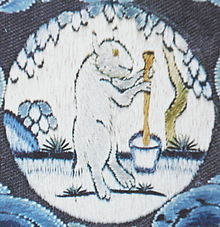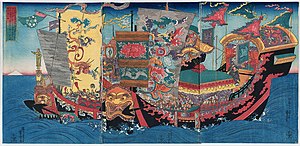Elixir of life
This article needs additional citations for verification. (August 2024) |

The elixir of life (Medieval Latin: elixir vitae), also known as elixir of immortality, is a potion that supposedly grants the drinker eternal life and/or eternal youth. This elixir was also said to cure all diseases. Alchemists in various ages and cultures sought the means of formulating the elixir.
History
[edit]Ancient Mesopotamia
[edit]An early mention of an elixir of life is found in the Epic of Gilgamesh (from the 2nd millennium BC) in which Gilgamesh comes to fear his own declining years following the death of his beloved companion Enkidu.[1] He seeks out Utnapishtim, a figure in Mesopotamian mythology known for surviving a great flood sent by the gods and being granted immortality. Gilgamesh is directed by Utnapishtim to find a plant at the bottom of the sea, but he loses it to a serpent before he can use it himself. This legend is an archaic explanation for snakes shedding their skin, seen as mystical rejuvenation.
China
[edit]
Many rulers of ancient China sought the fabled elixir to achieve eternal life. During the Qin dynasty, Qin Shi Huang sent Taoist alchemist Xu Fu to the eastern seas with 500 young men and 500 young women to find the elixir in the legendary Penglai Mountain, but returned without finding it. He embarked on a second voyage with 3000 young girls and boys, but none of them ever returned (legend has it that he found Japan instead).[2]
The ancient Chinese believed that ingesting long-lasting mineral substances such as jade, cinnabar, or hematite would confer some of that longevity on the person who consumed them.[3] Gold was considered particularly potent, as it was a non-tarnishing precious metal; the idea of potable or drinkable gold is found in China by the end of the third century BC. The most famous Chinese alchemical book, Danjing yaojue ("Essential Formulas of Alchemical Classics") attributed to Sun Simiao (c. 581 – c. 682 AD),[4][5] a famous medical specialist respectfully called "King of Medicine" by later generations, discusses in detail the creation of elixirs for immortality (including several toxic ingredients such as mercury, sulphur, and arsenates), as well as those for curing certain diseases and the fabrication of precious stones.
Many of these substances, far from contributing to longevity, were actively toxic and resulted in Chinese alchemical elixir poisoning. The Jiajing Emperor in the Ming dynasty died from ingesting a lethal dosage of mercury in the supposed "Elixir of Life" conjured by alchemists.[citation needed]
India
[edit]
Amrita, the elixir of life, has been described in Hindu scriptures. In the Puranas, that due to the defeat of the devas at the hands of the asuras, both power-seeking races, the preserver deity Vishnu asked the devas to churn the ocean of milk, so that they may retrieve amrita to empower themselves.[6]
Mercury, which was so vital to alchemy everywhere, is first mentioned in the 4th- to 3rd-century BC Arthashastra, about the same time it is encountered in China and in the West. Evidence of the idea of transmuting base metals to gold appears in 2nd- to 5th-century AD Buddhist texts, about the same time as in the West.
It is also possible that the alchemy of medicine and immortality came to China from India, or vice versa; in any case, for both cultures, gold-making appears to have been a minor concern, and medicine the major concern. But the elixir of immortality was of little importance in India (which had other avenues to immortality). The Indian elixirs were mineral remedies for specific diseases or, at the most, to promote long life.
Islamic world
[edit]See Alchemy in the medieval Islamic world.
Further information: Jabir ibn Hayyan, pseudo-Geber, Khalid ibn Yazid, Emerald Tablet, Picatrix, Brethren of Purity, Encyclopedia of the Brethren of Purity
Europe
[edit]
In European alchemical tradition, the elixir of life is closely related to the creation of the philosopher's stone. According to legend, certain alchemists have gained a reputation as creators of the elixir. These include Nicolas Flamel and St. Germain. A work by Michael Scot speaks of gold as an elixir of life.[7]
Japan
[edit]In the 8th century AD Man'yōshū, 'waters of rejuvenation' (変若水, ochimizu) are said to be in the possession of the moon god Tsukuyomi. Similarities have been noted with a folktale from the Ryukyu Islands, in which the moon god decides to give man the water of life (Miyako: sïlimizï), and serpents the water of death (sïnimizï). However, the person entrusted with carrying the pails down to Earth gets tired and takes a break, and a serpent bathes in the water of life, rendering it unusable. This is said to be why serpents can rejuvenate themselves each year by shedding their skin while men are doomed to die.[8][9]
Names
[edit]The Elixir has had hundreds of names (one scholar of Chinese history reportedly found over 1,000 names for it), among them Kimia, Amrit Ras or Amrita, Aab-i-Hayat, Maha Ras, Aab-Haiwan, Dancing Water, Chasma-i-Kausar, Mansarover or the Pool of Nectar, Philosopher's stone, and Soma Ras. The word elixir was not used until the 7th century A.D. and derives from the Arabic name for miracle substances, "al iksir". Some view it as a metaphor for the spirit of God (e.g., Jesus's reference to "the Water of Life" or "the Fountain of Life"). "But whoever drinks the water I give him will never thirst. Indeed, the water I give him will become in him a spring of water welling up to eternal life." (John 4:14) The Scots and the Irish adopted the name for their "liquid gold": the Gaelic name for whiskey is uisce beatha, or water of life.
“Kimia” is from Ancient Greek language and used in old Persian literature, in which it means something that transforms and brings life. Aab-i-Hayat is Persian and means "water of life".[10] "Chashma-i-Kausar" (not "hasma") is the "Fountain of Bounty", which Muslims believe to be located in Paradise. As for the Indian names, "Amrit Ras" means "immortality juice", "Maha Ras" means "great juice", and "Soma Ras" means "juice of Soma". Later, Soma came to mean the Moon. "Ras" later came to mean "sacred mood experienced listening to poetry or music"; there are altogether nine of them. Mansarovar, the "mind lake" is the holy lake at the foot of Mount Kailash in Tibet, close to the source of the Ganges.
In popular culture
[edit]The elixir of life has been an inspiration, plot feature, or subject of artistic works including animation, comics, films, musical compositions, novels, and video games. Some examples are L. Frank Baum's fantasy novel John Dough and the Cherub, the science fiction series Doctor Who, Natalie Babbitt's 1975 novel Tuck Everlasting and its film adaptation, Harry Potter and the Philosopher's Stone, House of Anubis, The Puppet Master, the manga Fullmetal Alchemist and Hell's Paradise: Jigokuraku, the light novel Baccano!, the movie Professor Layton and the Eternal Diva of the Professor Layton franchise, the horror film As Above, So Below and the series of video games Touhou Project and Sims 2.
See also
[edit]- Aether (mythology)
- Aether (classical element)
- Ageing
- Al Khidr
- Ambrosia and Nectar
- Amrita
- Cup of Jamshid
- Death Becomes Her
- Elixir
- Fountain of Youth
- Golden apple
- Holy Grail
- Ichor
- Immortality
- Jintan (Japanese medicine)
- Magu (deity)
- Manna
- Panacea
- Peaches of Immortality
- Philosopher's stone
- Pill of Immortality
- Potion
- Rejuvenation
References
[edit]- ^ "The Epic of Gilgamesh: Enkidu". SparkNotes. Retrieved 2022-12-27.
- ^ Liu, Hong. The Chinese Overseas. Routledge Library of Modern China. Published by Taylor & Francis, [2006] (2006). ISBN 0-415-33859-X, 9780415338592.
- ^ Johnson, Obed Simon. A Study of Chinese Alchemy. Shanghai, Commercial Press, 1928. rpt. New York: Arno Press, 1974. page 63
- ^ Glick, T.F., Livesey, S.J., Wallis, F. Medieval Science, Technology And Medicine: An Encyclopedia. Routledge, 2005. p. 20
- ^ "Tan chin yao chueh – occultism". britannica.com.
- ^ Chaturvedi, B. K. (2006). Vishnu Purana. Diamond Pocket Books (P) Ltd. p. 25. ISBN 978-81-7182-673-5.
- ^ Multhauf, R.P. (1953). The Relationship Between Technology and Natural Philosophy, Ca. 1250-1650 as Illustrated by the Technology of the Mineral Acids. University of California. Retrieved 2023-06-04.
- ^ Nelly Naumann (2000). Japanese Prehistory: The Material and Spiritual Culture of the Jōmon Period. Otto Harrassowitz Verlag. p. 133. ISBN 978-3-447-04329-8.
- ^ Nevsky, Nikolai (April 1971). Masao, Oka (ed.). 月と不死 [Tsuki to fushi] (in Japanese). 平凡社. ISBN 9784582801859. Retrieved 17 December 2018.
- ^ I. K. Poonawala. "ĀB ii. Water in Muslim Iranian culture". Encyclopaedia Iranica. Retrieved 12 February 2012.
Bibliography
[edit]- Heart of the Earth: The Elixir of Earth, second novel in the trilogy by Richard Anderson no
- Al-Khidr, The Green Man
- Alchemy and Daoism Archived 2020-02-14 at the Wayback Machine
- Naam or Word, Book Three: Amrit, Nectar or Water of Life
- Needham, Joseph, Ping-Yu Ho, Gwei-Djen Lu. Science and Civilisation in China, Volume V, Part III Archived 2014-11-27 at the Wayback Machine. Cambridge at the University Press, 1976.
- Turner, John D. (transl.). The Interpretation of Knowledge
